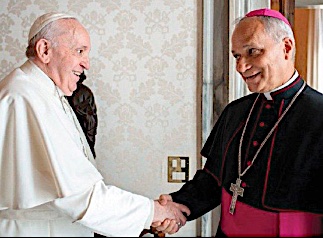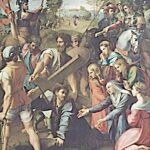Pope Leo has left us his personal memories of Pope Francis
“He taught us to live the joy of the Gospel”
Cardinal Prevost’s last interview with Vatican media released the day after Francis’ death. “He taught us to live the joy of the Gospel”
We repeat what the then Cardinal Robert Prevost said the day after the death of Pope Francis,
whom he had known when he was archbishop of Buenos Aires.
The following is our English translation from the Italian copyright
by TIZIANA CAMPISI (of L’Osservatore Romano )
These are the traits of Pope Francis’ personality that have always struck Cardinal Robert Prevost. Consistency, authenticity, and a particular closeness to the poor and suffering.
And then there is his love for the Church, his desire to “give everything to serve her,” and his sense of responsibility.
The Augustinian religious * (then, Cardinal Robert Prevost) confided to Vatican media that he had always appreciated Pope Francis for his “authentic Christian heart,” his “generosity,” his “charity,” and his “desire to live this dimension of the Gospel until his last days.”
Cardinal Prevost was moved to share his personal memories of the pontiff.
He recounted meeting Jorge Mario Bergoglio when he was archbishop of Buenos Aires, describing some aspects of his character and recounting anecdotes.
“I always had the impression of a man who wanted to live the Gospel authentically and consistently,” he said.
“When I was prior general of the Augustinians, I had the opportunity to meet him several times during visits to my confreres in Argentina, when he was still a cardinal, and to talk with him informally and on more institutional matters.”
After being elected pope, Francis celebrated his first public Mass on March 13, 2013, in the parish of St. Anne in the Vatican, entrusted to the pastoral care of the Augustinian religious, and on that occasion Prevost met him again.
“I wondered if he remembered me, and when he arrived and entered the sacristy, he immediately recognized me and we began to talk.”
The dialogue with the then Prior General of the Order of Saint Augustine continued. “At the end of my term, in that same year, we thought of inviting the Holy Father to preside over the opening Mass of the General Chapter on August 28” in the Basilica of St, Augustine in Campo Marzio, Rome.
Bergoglio, “to everyone’s surprise,” accepted with pleasure.
He knew that particular church well because when he came to the capital as cardinal, he always stayed nearby, at the Casa del Clero, in Via della Scrofa, and went to pray at the tomb of St. Monica, which is kept there.
A little over a year later, on November 3, 2014, Francis appointed Fr. Robert Prevost apostolic administrator of the diocese of Chiclayo, Peru, and later bishop.
As pastor of that small flock in the Lambayeque region, the Augustinian religious
met the Pope again. Pope Francis was always very attentive to missionary service.
“He asked me: ‘How are you? How are things going?’” Prevost recalls.
Prevost added: ‘He gave so much to the Church, and his gestures of closeness speak so eloquently.”
Robert Prevost also recalls Francis’ apostolic visit to Peru in 2018, and the 99-year-old blind woman who arrived in Trujillo because she wanted to meet the Pope.
“He got out of the car, approached her, and greeted her. He left us many examples of this kind; in his beautiful humanity, he wanted to live the Gospel and transmit the Gospel,” observes the cardinal.
Bergoglio also highlights the joy that shines through in the Apostolic Exhortation Evangelii gaudium “on the proclamation of the Gospel in today’s world.
He reminds us of what the Gospel says, and what we repeat during this Easter season: to live the joy of the Gospel, of faith, and to recognize Jesus Christ.
Cardinal Prevost’s thoughts then turn to Pope Francis’ first apostolic journey, which took place on July 8, 2013, in Lampedusa.
He referred to his “closeness to migrants”. Even in last February he wrote a letter to the USA bishops, emphasizing ”the importance of being close to those who suffer and of having the heart of Jesus Christ.” It was a time when US government which was implemented its program of mass deportation of illegal immigrants and refugees.
Cardinal Prevost then mentioned Bergoglio’s last visit to the Regina Coeli prison in Rome on Holy Thursday, a gesture that “speaks volumes: his desire to go, despite his many health problems and difficulties, to celebrate this important day in the life of the Church with the prisoners, as he did every year, and thus communicate this closeness, this love that Jesus left to all of us.”
Cardinal Prevost, as prefect of the Dicastery for Bishops, had a regular appointment with Pope Francis every Saturday morning over a period of nearly two years.
Speaking of his weekly meeting with the Pontiff Cardinal Prevost said:
“Until the end of his life, he wanted to give everything to his ministry, to his work, to his service in the Church.” “At first it was at 8 a.m. But sometimes I would arrive at 7:30 and he was already waiting for me, so I started going a little earlier and sometimes he would come early.”
Important topics were discussed, but Pope Francis often added a recommendation: “He would say to me, among other things, at the end of the audience:
‘Don’t lose your sense of humor, you have to smile.’”
The Augustinian cardinal recalls St. Thomas More’s ‘Prayer of Good Humor,’ which
the Pope has quoted several times to urge us to move forward inmatters of great responsibility, with great trust in the grace of the Lord.
Robert Prevost continued: ‘Pope Francis spared no effort in serving the Church, specifying that the Pontiff was always “very well informed about things.”
“Many times, before I arrived, he had studied the issues and knew what decisions he wanted to make. He really followed not only the work of the Dicastery for Bishops, but also—I know this from conversations with various prefects—that of other Dicasteries.” He loved the Church very much and “carrying on what he had understood was part of his mission. He was tireless, even in these last weeks, after his hospitalization
at the Gemelli Hospital in Rome to treat bilateral bronchopneumonia”.
‘When he returned to Santa Marta, we had a few meetings, and I was able to see how courageous he was; he gave his all to serve the Church.”
In his pontificate, Bergoglio “has conveyed to all of us this spirit of wanting to continue what began with the Second Vatican Council, the need to always renew the Church, “semper reformanda est,” reflects the Augustinian cardinal again, who recalls the answers given by the Pontiff in an interview about the great assembly desired by John XXIII.
Robert Prevost continued “’There is still much to be done, we must continue a spirit, a fundamental attitude for all of us”.
We cannot stop and we cannot turn back.
We must see how the Holy Spirit wants the Church to be today and tomorrow, because the world of today, in which the Church lives, is not the same as the world of ten or twenty years ago.
He remarked “The message is always the same, proclaiming Jesus Christ, proclaiming the Gospel, but the way of reaching people today is different, young people, the poor, politicians”.
Robert Prevost emphasizes that the Pope has left a strong message to the world’s authorities and it is necessary to go “forward.”
Among Francis’ teachings is also to treasure “the ‘love for the poor,” the cardinal then notes. He wants “a poor Church, which walks with the poor, which serves the poor,” because the message of the Gospel is understood much better from the experience of the poor, who have nothing, who try to live the faith and find in Jesus Christ everything. I believe that in this sense the Pope has left a very great example for the world.
He left a very great example to me personally, because of my work as a bishop in Peru, as a missionary, and because of so many other things.”
But how to take up Francis’ legacy?
“Difficult to answer” just hours after the pontiff’s death, Robert Prevost objectively acknowledges. “I personally believe that this period of loss, of sadness, should be lived in silence, with deep reflection and gratitude.
I, at least, will need a lot of time to truly understand what the Pope left to me, to the Church and to the world,” concludes the then prefect of the Dicastery for Bishops.
It is therefore necessary, he concludes, “to live this moment like Holy Saturday,” looking at the great mystery that is life in the way Jorge Mario Bergoglio wanted to teach us.


